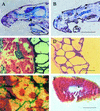Aquatic insects as a vector for Mycobacterium ulcerans
- PMID: 12200321
- PMCID: PMC124085
- DOI: 10.1128/AEM.68.9.4623-4628.2002
Aquatic insects as a vector for Mycobacterium ulcerans
Abstract
Mycobacterium ulcerans is an emerging environmental pathogen which causes chronic skin ulcers (i.e., Buruli ulcer) in otherwise healthy humans living in tropical countries, particularly those in Africa. In spite of epidemiological and PCR data linking M. ulcerans to water, the mode of transmission of this organism remains elusive. To determine the role of aquatic insects in the transmission of M. ulcerans, we have set up an experimental model with aquariums that mimic aquatic microenvironments. We report that M. ulcerans may be transmitted to laboratory mice by the bite of aquatic bugs (Naucoridae) that are infected with this organism. In addition, M. ulcerans appears to be localized exclusively within salivary glands of these insects, where it can both survive and multiply without causing any observable damage in the insect tissues. Subsequently, we isolated M. ulcerans from wild aquatic insects collected from a zone in the Daloa region of Ivory Coast where Buruli ulcer is endemic. Taken together, these results point to aquatic insects as a possible vector of M. ulcerans.
Figures




References
-
- Asiedu, K., R. Sherpbier, and M. C. Raviglione. 2000. Buruli ulcer Mycobacterium ulcerans infection. WHO Global Buruli Ulcer initiative. Report 2000. World Health Organization, Geneva, Switzerland.
-
- Darie, H., T. Le Guyadec, and J. E. Touze. 1993. Epidemiological and clinical aspects of Buruli ulcer in Ivory Coast: 124 recent cases. Bull. Soc. Pathol. Exot. 86:272-276. (In French.) - PubMed
-
- De Gentile, P. L., C. Mahaza, F. Rolland, B. Carbonnelle, J. L. Verret, and D. Chabasse. 1992. Cutaneous ulcer from Mycobacterium ulcerans. Apropos of 1 case in French Guyana. Bull. Soc. Pathol. Exot. 85:212-214. (In French.) - PubMed
Publication types
MeSH terms
LinkOut - more resources
Full Text Sources
Medical

